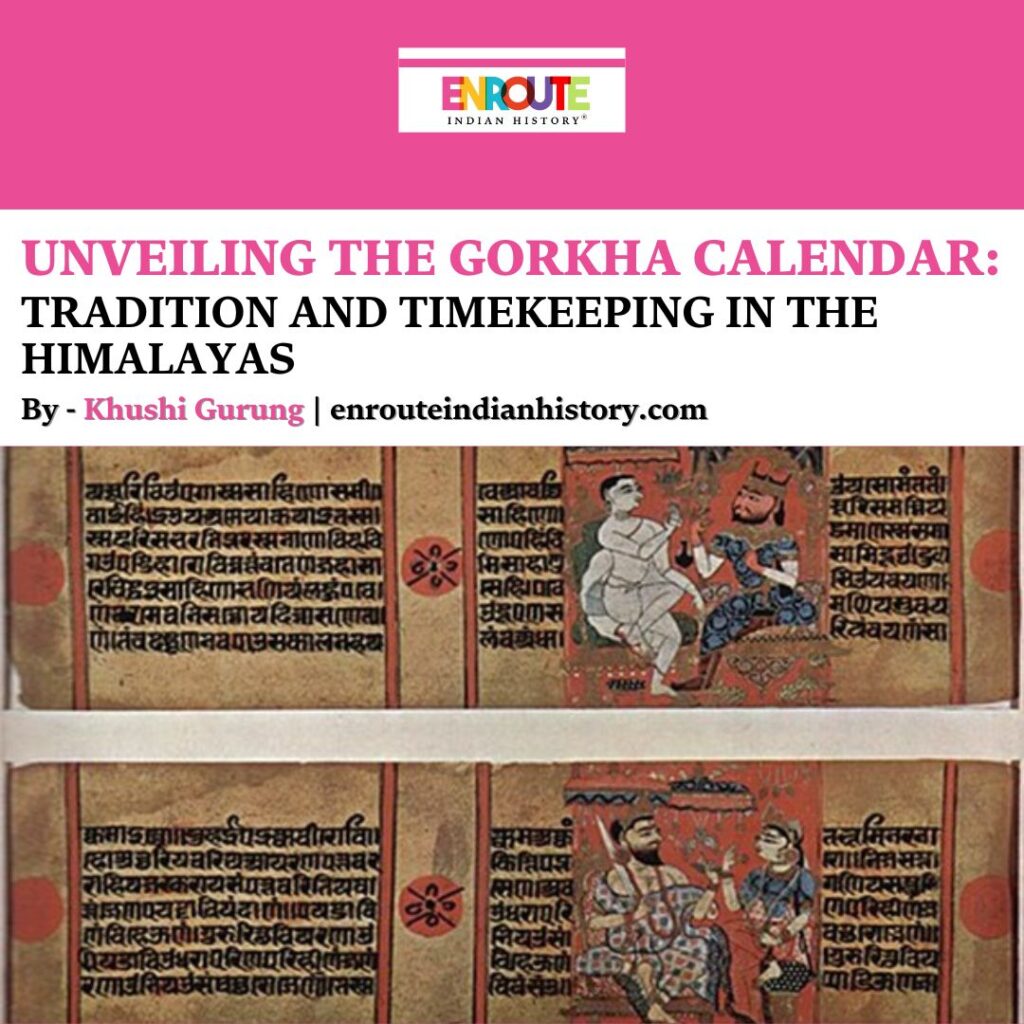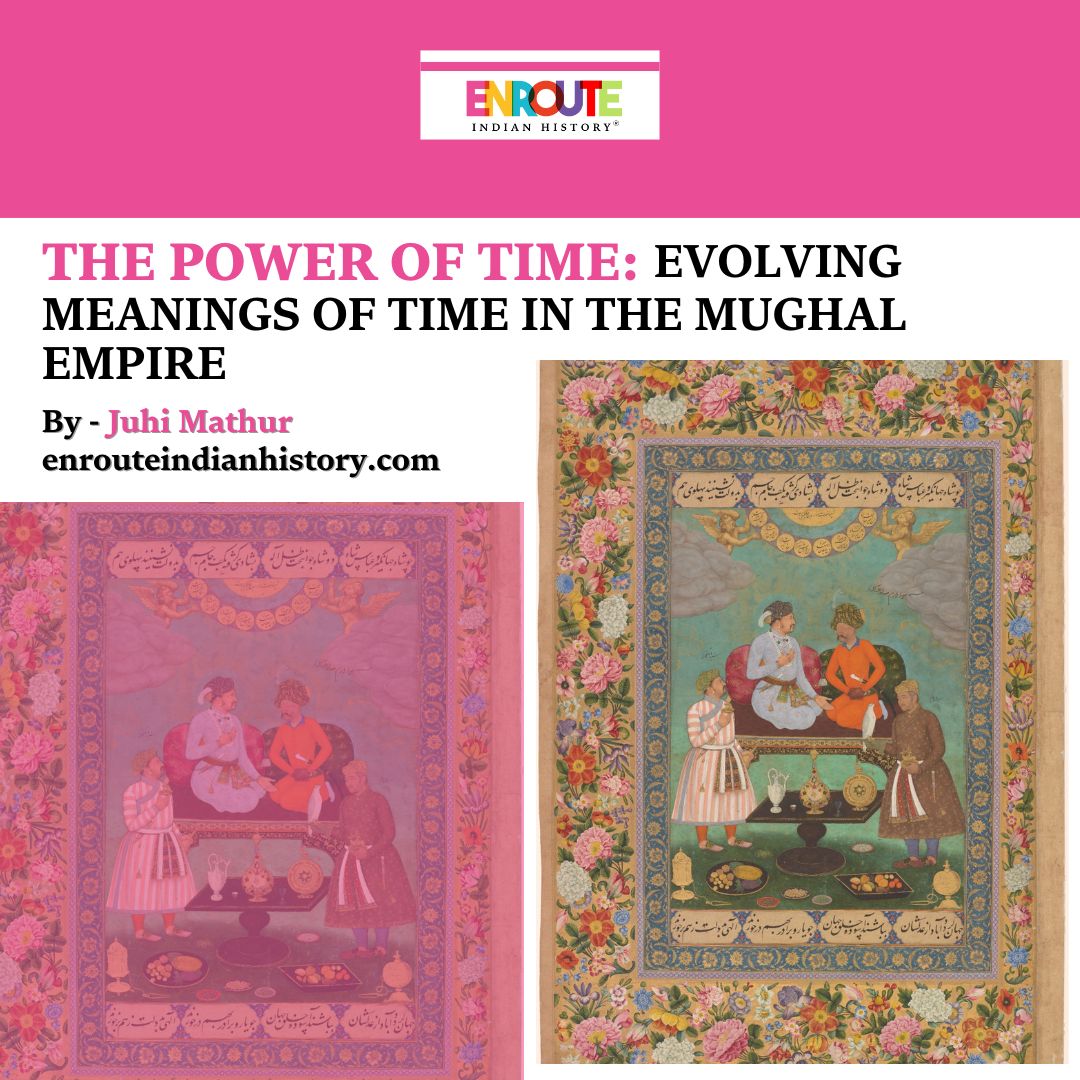Unveiling the Gorkha Calendar: Tradition and Timekeeping in the Himalayas
- enrouteI
- September 11, 2024


Source: WikiComms, The Hindu Calendar 1871-72
The Gorkha calendar, also known as Bikram Sambat, is a traditional lunisolar calendar widely used by the Nepali-speaking Gorkha community in Darjeeling and Sikkim, India. Rooted in the historical legacy of King Vikramaditya of India, who established this calendar in 57 B.C., the Bikram Sambat holds profound significance for the cultural and daily lives of these communities. Distinct from the Gregorian calendar, the Gorkha calendar combines lunar months with solar years, creating a system that aligns both with the moon’s cycles and the sun’s course. This makes it not only a tool for marking time but also a key element in cultural and religious observances. For instance, festivals such as Dashain (Dusshera), Tihar, and Maghe Sankranti (Makar Sankranti) are scheduled according to the Bikram Sambat, reflecting its central role in organizing and celebrating these significant events. Despite the prevalence of the Gregorian calendar globally, the Gorkha calendar remains integral to the identity of the Nepali communities in Darjeeling and Sikkim, guiding agricultural practices, religious ceremonies, and cultural traditions. Its continued use underscores its enduring importance in maintaining cultural heritage and communal unity in these regions.
It follows the solar Hindu calendar system. It is primarily used by the Gorkha people and many Nepali communities worldwide. The calendar operates on a lunisolar model, blending both solar and lunar cycles, with years usually comprising 12 months, like the Gregorian calendar, but being approximately 56.7 years ahead. The Bikram Sambat era is believed to have started in 58 BCE, named after King Vikramaditya of India, who established the Vikram era following his victory over the Sakas.
Early Beginnings and Adoption
The widely believed origin story of Bikram Sambat (or Vikram Sambat) is related to King Vikramaditya of Ujjain. Legend has it that it was established by the King, after defeating the Śakas. As written in the Jain historical book named “Kalakacharya Kathanaka”, a monk called Kalakacharya’s sister Sarasvati was abducted by the powerful Ujjain king, Gandharvasena. Seeking vengeance, the monk turned to the Śaka ruler King Sahi in Sistan for help. Despite the odds and with the aid of miracles, King Sahi defeated Gandharvasena and captured him. But Gandharvasena was forgiven and he retired to a forest, where he met his demise at the jaws of a tiger. However, his son, Vikramaditya, grew up in the forest and later invaded Ujjain, driving out the Śakas. To commemorate this victory over Sakas, he began the “Vikrama era.” However, there is also a different stream of belief about this. Some researchers have pointed out that, despite many archaeological studies, no kingdom of King Vikramaditya has yet been found to have existed during the time Bikram Sambat started. Thus, they believe it to be a Sambat which started originally in the Nepalese region by a Nepalese King name Vikramaditya. Other researchers go even further and believe it is not to be associated with any Kings at all. They find deeper meaning and associated it with the Sun. Interestingly, the term ‘Aditya’ in Sanskrit translates to ‘Sun’ in English.

Source: hmong, The Jain monk Kalakacharya and the Saka king (Kalakacharya Katha manuscript, Chhatrapati Shivaji Maharaj Vastu Sangrahalaya, Mumbai)
Over the centuries, the Bikram Sambat calendar has been used in various parts of South Asia, particularly in Nepal and some parts of India like Darjeeling and Sikkim regions. . It is primarily used by the Hindu communities to calculate the dates of festivals and events. It has served as a basis for many cultural and religious festivals, as well as for official purposes in Nepal, where it is the official calendar system.
According to some legends, the use of Bikram Sambat in Nepal started during the reign of King Jayasthiti Malla in the 14th century. The king was impressed by the accuracy and precision of the calendar system and adopted it as the official calendar of Nepal. Since then, it has been widely used in the country as well as in some parts of South Asia and is an important part of cultural and religious traditions. The use of Bikram Sambat is seen in many places, by many kings, throughout the history of Nepal. The calendar plays a crucial role in Gorkha culture. Festivals such as Dashain, Tihar, and other Hindu observances are calculated using the Bikram Sambat dates. It also serves as a marker for agricultural activities, guiding the timing of planting and harvest seasons. The Gorkha calendar is used in government, media, and everyday life throughout Nepal and Indian regions of Sikkim and Darjeeling. Public holidays, official documents, and traditional events are all recorded according to this system. However, the Gregorian calendar is also widely used, particularly for international relations and business. Despite its ancient origins, the Gorkha calendar remains deeply integrated into the fabric of Nepali life, connecting people to their cultural roots while marking the passage of time in both religious and practical contexts.
Features and Difference between the Gregorian and Gorkha Calendar
Imagine living in two worlds, where time itself is measured differently—where one calendar marks a year as 2024 while another proudly stands at 2081. This is the reality for the Gorkha community using the Bikram Sambat calendar alongside the globally recognized Gregorian calendar. These two calendars, though both guide daily life and special occasions, reflect distinct philosophies in their approach to time.

Source: Khushi Gurung,The traditional Nepali Gorkha Calendar (Nepali Language, Devnagari Script)
Time and Year: The Bikram Sambat is approximately 56.7 years ahead of the Gregorian calendar. For instance, while the world currently observes the year 2024 in the Gregorian system, the corresponding year in the Bikram Sambat is 2081 B.S. This significant difference arises from the origins of each calendar: the Gregorian calendar is based on the birth of Christ (Anno Domini), whereas the Bikram Sambat starts from 57 B.C., marking the victory of King Vikramaditya over the Sakas.
Months and Structure: The Gregorian calendar follows a purely solar cycle, dividing the year into 12 months of fixed lengths, ranging from 28 to 31 days. In contrast, the Bikram Sambat is lunisolar, meaning it considers both the moon’s phases and the sun’s position. Each month in the Bikram Sambat can have 29 to 32 days, depending on the lunar cycle, with festivals and cultural events tied closely to lunar phases.
Leap Year Calculations: Leap years in the Gregorian calendar are determined by a rule: a leap year occurs every four years, except for years divisible by 100 but not 400. This keeps the calendar aligned with Earth’s orbit around the sun. In the Bikram Sambat, leap years are also based on solar calculations, but the additional days are often adjusted within the months themselves, not by adding a day to the year.
These differences make the Bikram Sambat calendar a more complex yet culturally significant system, reflecting the Gorkha community’s deep ties to both celestial and agricultural cycles.
Structure and Composition
The Gorkha calendar follows a lunisolar system, blending both the lunar phases and the solar year to determine the passage of time. This dual structure aligns the calendar with celestial movements, making it both complex and highly relevant for cultural and agricultural practices in the Gorkha community. In a lunisolar calendar, months are determined by the lunar cycle, but the calendar year is synchronized with the solar cycle. Similarly, the Gorkha calendar consists of 12 months, each beginning with the new moon, and it incorporates adjustments to align the year with the Earth’s orbit around the sun. While lunar months typically consist of 29 to 32 days, the total number of days in a year is adjusted by adding or removing days in certain months to keep the calendar aligned with the solar year. The months are named after ancient Sanskrit terms, such as Baishakh, Jestha, Ashad, and Shrawan. The calendar does not just list the days; it is enriched with various spiritual and astrological elements like horoscope predictions, Maasphal, Chaad Parv, and Chandra Vichar, which play a significant role in the cultural practices of the Gorkha community.
Horoscope Predictions in the Gorkha Calendar
A unique feature of the Gorkha calendar is the inclusion of horoscope predictions for each month. These predictions are based on astrology and the positioning of celestial bodies. Each month, people can consult the calendar for their rashifal, or horoscope, which provides insight into their health,

Source: Khushi Gurung, Observe the horoscope predictions listed beneath each month in the calendar.
financial prospects, relationships, and general well-being for that specific period. The horoscope section is often viewed with great respect, as many believe that the positions of the stars and planets can influence their daily lives. These predictions guide decision-making, whether in personal life (e.g., marriage, business ventures) or in communal affairs. The horoscope readings are tied closely to the lunar cycle, ensuring that they are in sync with the astrological positioning of the moon, stars, and planets.
Maasphal: Prediction of the Overall Month
The Maasphal is another fascinating aspect of the Gorkha calendar. It refers to the general prediction of the entire month, offering insights into the overarching mood or energy of that period. This section is used to give an overview of the month’s potential challenges or positive outcomes, focusing on the overall flow of time. The Maasphal is often read at the beginning of each month to help people prepare for the spiritual and material aspects of life during that period. The Maasphal includes important guidance on the best days for specific activities, such as religious practices, agricultural work, or significant life events like weddings or business openings. The predictions help the community synchronize its activities with the favourable or unfavourable astrological
conditions of the month.
Based on the image above, the Maasphal outlines the month’s predictions as follows:
यो महिनामा कतेई–कतेई वर्षा र गर्मीले गर्दा मौसमी बीमारी– ज्वरों, खोकी, डेंगू जस्ता बीमारी को प्रभाव बढ़ने। समान धातुहारू सामान्य
Translation: Due to frequent rains and heat in this season, the effect of seasonal diseases like fever, cough, dengue increases. The characteristics of elements are normal.
Chaad Parv: Festivals Under Each Month:
The Gorkha calendar is also a cultural roadmap, guiding the celebration of important festivals through the Chaad Parv section. This column provides a list of festivals and religious observances that fall under each particular month. Some of the major festivals, such as Dashain, Tihar, and Maghe Sankranti, are celebrated according to the dates in the Bikram Sambat calendar. The exact dates of these festivals depend on the lunar phases and are often seen as auspicious times for family gatherings, religious rituals, and communal activities. For instance, the Dashain festival, which is one of the largest festivals in the Nepali-speaking world, is celebrated in the month of Ashwin and is marked in the Chaad Parv column. This section is crucial for organizing family and community events, ensuring that important rituals and festivals are observed at the right time.
Chandra Vichar: Predictions Based on Lunar Phases
Another critical aspect of the Gorkha calendar is the Chandra Vichar, or predictions based on the phases of the moon. The moon holds immense importance in astrology, and its waxing and waning phases are closely monitored to determine auspicious and inauspicious times for various activities. The Chandra Vichar helps predict the ideal dates for starting new ventures, performing religious ceremonies, and celebrating festivals. Each phase of the moon brings its own energy, and the calendar reflects this through detailed Chandra Vichar predictions. For example, the full moon (Purnima) is often considered a time of heightened spiritual energy and is used for fasting, prayers, and rituals. Similarly, the new moon (Amavasya) might be seen as a period for introspection and new beginnings.
Mantras Associated with Each Month
In addition to astrological and lunar elements, the Gorkha calendar includes mantras for each month. These mantras are recited to invoke blessings, protection, and prosperity. Each month carries its own set of spiritual meanings, and the corresponding mantra serves as a guide for individuals seeking divine favour. The recitation of these mantras is believed to enhance the positive energies associated with the astrological and lunar cycles of that month. For example, during the month of Baishakh, which marks the Nepali New Year, special mantras are chanted to bless the year ahead. These mantras are often tied to specific deities worshipped during that month and are part of larger religious observances.
Conclusion
In conclusion, the Gorkha calendar (Bikram Sambat) stands as a vital cultural and spiritual tool for the Nepali-speaking Gorkha community, especially in regions like Darjeeling and Sikkim. Its lunisolar structure intertwines timekeeping with astrology, religious observances, and cultural traditions, reflecting a deep connection to both celestial movements and spiritual beliefs. The calendar’s features, such as horoscope predictions, masphal, chad parv, chandra vichar, and monthly mantras, provide comprehensive guidance for the community’s personal, agricultural, and religious practices. It not only tracks the passage of time but also harmonizes life with the universe’s cycles, making it far more than a simple calendar. The Gorkha calendar’s integration of astrology, lunar phases, and spiritual rituals underscores its enduring relevance and importance in preserving cultural heritage, offering a unique approach to time and life management that continues to shape the Gorkha identity.
Bibliography
Shrestha, Bal Gopal. The Ritual Composition of Nepal: On Time and Identity. Brill, 2020.
Whelpton, John. A History of Nepal. Cambridge University Press, 2005.
Stiller, Ludwig F. The Rise of the House of Gorkha: A Study in the Unification of Nepal, 1768–1816. Manjusri Publishing House, 1973.
Acharya, Puspa Raj. Bikram Sambat: The Traditional Nepali Calendar. Kathmandu: Ratna Pustak Bhandar, 2019.
Bhattarai, Binod. “The Significance of the Bikram Sambat Calendar in Nepali Culture.” Nepal Journal of Culture and History, Vol. 12, No. 4, 2017, pp. 45-56.
Gurung, Tika. Timekeeping in the Gorkha Community: A Cultural Study of the Bikram Sambat Calendar. Darjeeling: Himalayan Publishing House,2020.
Malla, Kamal. “Astrological Practices and the Bikram Sambat: A Historical Perspective.” Journal of Himalayan Studies, Vol. 10, No. 2, 2015, pp. 32-40.
- September 12, 2024
- 12 Min Read
- October 29, 2023
- 9 Min Read



















